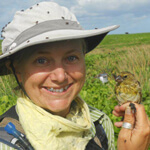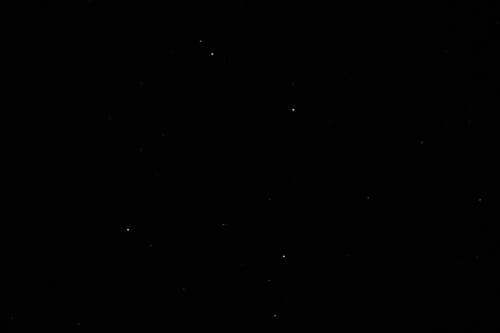Fledgling Explorers on Laysan Island
May 20 – June 2, 2013
Michelle Wilcox
We now have at least 100 Millerbirds on Laysan Island! In the past two weeks, we've discovered a few more unbanded adult females nesting with banded males. This brought our number of adults up to 75. The number of Millerbird fledglings for the year is up to 25 — closing in on last year's count of 29. There is still plenty of time to exceed that number before the breeding season ends this year.
There seems to be no slowing down: In this two-week period, we've discovered five new nests being built and we are still monitoring five pairs that are incubating eggs, two pairs with nestlings, and eight pairs that fledged young.
After three to four weeks of being fed by their parents, the Millerbird fledglings start moving around on their own. They are highly curious, silent, and will show up suddenly near your feet, peering up at you from the exposed edge of a naupaka bush. The fledglings train one eye, then the other on you, noticeably trying to figure out what you are.
By banding chicks in the nest, we can tell where they hatched and compare that to where we detect them later. One adventurous fellow has already been seen exploring one-third of a mile away from the nest where he fledged only six weeks prior. He may have been attracted to Millerbirds in other territories, but he was definitely out exploring his new world. By observation we hope to learn about the new fledglings' movements and their interactions with other Millerbirds.
Nature Sighting of the Week
Over the past few weeks, we have been enjoying the sparkling lights of the night sky with a spotting scope and a good star book. The constellation Corvus has been a great starting point. Easy to spot in the south, this trapezoid of stars is otherwise known as the crow, a messenger to Apollo. It is now a messenger to us, since it helps point our way to the group of stars on the horizon called the Southern Cross. Hawai‘i is one of the only places in the United States where you can see from the Southern Cross to the North Star in the same night sky.
We have also been able to see the star Sirius sparkling like a fireworks display, as well as a number of planets including Jupiter, Venus, and Mercury. Grandest of all, we were able to see the rings of Saturn through the spotting scope.
The stargazing on Laysan is spectacular. With no civilization or light pollution for up to 800 miles in every direction, how could we expect anything different?
Other Bird News
The Laysan Albatross chicks are losing their down feathers, replacing them with body and wing feathers.They now sport gray down on their too-short primary wing feathers, but they are practicing flapping nonetheless. Flapping while sitting on the ground looks a bit silly, but they have the right idea.
We have a colony of thousands of Sooty Terns that seems to be indecisive about where it wants to lay their eggs en masse this year. They keep touching down in an area, and a few of them lay eggs, but then the rest move to a new area. We continue to see a small number of Pacific Golden-Plovers, Ruddy Turnstones, Sanderlings, Wandering Tattlers, and Bristle-thighed Curlews. We guess most of these birds are probably foregoing their trip to their breeding grounds this year and are going to stay on Laysan through the summer. The more, the merrier: Brown Noddies have come to camp, and they are courting and choosing breeding locations.Also, a very few Tristram's Storm Petrel fledglings have also shown their faces around the island.
Meanwhile, we'll keep counting Millerbirds, stargazing, and bird watching here on Laysan. Look for more from us in two weeks!
 Michelle Wilcox is a Millerbird biologist with American Bird Conservancy.
Michelle Wilcox is a Millerbird biologist with American Bird Conservancy.




















































